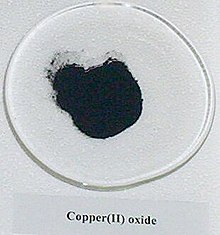 | |
 | |
 | |
| Names | |
|---|---|
| IUPAC name Copper(II) oxide | |
| Other names Cupric oxide | |
| Identifiers | |
3D model (JSmol) | |
| ChEBI | |
| ChEMBL | |
| ChemSpider | |
| ECHA InfoCard | 100.013.882 |
| EC Number |
|
PubChem CID | |
| RTECS number |
|
| UNII | |
CompTox Dashboard (EPA) | |
| |
| |
| Properties | |
| CuO | |
| Molar mass | 79.545 g/mol |
| Appearance | black to brown powder |
| Density | 6.315 g/cm3 |
| Melting point | 1,326 °C (2,419 °F; 1,599 K) |
| Boiling point | 2,000 °C (3,630 °F; 2,270 K) |
| insoluble | |
| Solubility | soluble in ammonium chloride, potassium cyanide insoluble in alcohol, ammonium carbonate |
| Band gap | 1.2 eV |
| +238.9·10−6 cm3/mol | |
Refractive index (nD) | 2.63 |
| Structure | |
| monoclinic, mS8 [1] | |
| C2/c, #15 | |
a = 4.6837, b = 3.4226, c = 5.1288 α = 90°, β = 99.54°, γ = 90° | |
| Thermochemistry | |
Std molar entropy (S⦵298) | 43 J·mol−1·K−1 |
Std enthalpy of formation (ΔfH⦵298) | −156 kJ·mol−1 |
| Hazards | |
| GHS labelling: | |
  | |
| Warning | |
| H302, H410, H412 | |
| P264, P270, P273, P301+P317, P330, P391, P501 | |
| NFPA 704 (fire diamond) | |
| Flash point | Non-flammable |
| NIOSH (US health exposure limits): | |
PEL (Permissible) | TWA 1 mg/m3 (as Cu) [2] |
REL (Recommended) | TWA 1 mg/m3 (as Cu) [2] |
IDLH (Immediate danger) | TWA 100 mg/m3 (as Cu) [2] |
| Safety data sheet (SDS) | Fisher Scientific |
| Related compounds | |
Other anions | Copper(II) sulfide |
Other cations | Nickel(II) oxide Zinc oxide |
Related compounds | Copper(I) oxide |
Except where otherwise noted, data are given for materials in their standard state (at 25 °C [77 °F], 100 kPa). | |
Copper(II) oxide or cupric oxide is an inorganic compound with the formula CuO. A black solid, it is one of the two stable oxides of copper, the other being Cu2O or copper(I) oxide (cuprous oxide). As a mineral, it is known as tenorite, or sometimes black copper. It is a product of copper mining and the precursor to many other copper-containing products and chemical compounds. [3]
